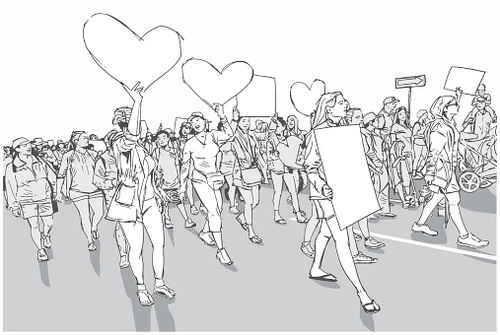1. Select a discrete app icon.

notes
The Book That's an Urgent Wake-Up Call
Our next Book Club selection, No Visible Bruises, shines a light on the epidemic of violence that continues to plague us
- Aug 14, 2019

“People don’t want to read about domestic violence,” says author and international journalist Rachel Louise Snyder who just published a book about domestic violence. Yet her book, No Visible Bruises: What We Don’t Know About Domestic Violence Can Kill Us is receiving more attention and acclaim than any domestic violence-related tome in a long time. It’s been held in acclaim by The Atlantic, NPR, The Guardian, The Washington Post. The New York Times called it “extraordinary.”
And no, it’s not a self-help book. It’s also not a memoir. It definitely doesn’t have a happy ending.
“I didn’t want to write a beach read,” says Snyder, 50, who resides in Washington, D.C. and who has long written about humanitarian issues, social ills and women’s rights.
“I’ve always been sort of attracted to that, but I really didn’t have a focus on domestic violence, though it was part of every story.”
Her new book, her third to be published is, simply put, gripping. So much so that you might not even notice you’re reading about domestic violence, says Snyder. And yet you are—you’re reading about the problem as it exists today, to real people of all walks of life, stories of the victims as well as the abusers, along with advice from those in the field trying to do what feels tantamount to putting out a forest fire with a spray bottle.
It opens with the story of Snyder going to visit a father named Paul in Billings, Montana. Paul’s front door has a dent in it from the time his ex-son-in-law tried to kick it in to get to Paul’s daughter. His late daughter, whom his son-in-law murdered, along with Paul’s two grandchildren.
How Snyder got Paul to open to him in the midst of unimaginable grief is a testament to how Snyder approaches domestic violence—a combination of empathy, anger and shared disbelief as to how this can keep happening, and how we can keep ignoring it.
That’s why DomesticShelters has chosen Snyder’s latest release as our third book club selection. Below, an introduction to the author behind this transfixing and eye-opening book.
Read, Ask Questions
We invite you to read No Visible Bruises over the next month, then submit your questions or comments about it to Amanda@DomesticShelters.org by Monday, Sept. 30. We’ll pose your questions to the author and follow-up again with Snyder’s responses.
Donate and change a life
Your support gives hope and help to victims of domestic violence every day.
DomesticShelters: What’s your reaction been like to the response your book has been getting?
Snyder: “At first, it was like, ‘Where have all you people been?’ But I get it—it’s tapping into women’s rage in this particular cultural moment. It’s part of a national conversation we’re having.”
DS: How long did it take you to research this book?
Snyder: “In some ways I’ve been researching it for the last nine years but I wrote it very quickly. Some is refashioned from New Yorker pieces [I wrote]. I wrote the book in six months, but the research was about nine years. It takes a long time to understand the particular psychology and nuance of domestic violence.”
DS: Who did you write this book for? Advocates? Survivors? Abusers? Teens about to enter their first relationship? Parents worried about teens entering their first relationship?
Snyder: “Yes. I wanted to write a book for people who didn’t know that they could be interested in something like domestic violence. I wanted abusers and victims alike to feel like their voices were being amplified. I didn’t want to write a book just about the darkness of domestic violence. There are a lot of solutions in this. The first part is from victim’s point of view, the second from abuser’s and the third part from the changemaker’s and advocate’s.”
DS: In the preface, you say, “…if I thought of domestic violence in the States at all, I saw it as an unfortunate fate for the unlucky few, a matter of bad choices and cruel environments.” This accurately describes a common stereotype of domestic violence—that it’s, in part, a woman’s poor choice of a partner, and it only happens in, as you say, cruel environments, like low-income, low-education demographics. In actuality, as you know, it’s an epidemic that affects nearly a third of the women in this country across all geographic, cultural and socioeconomic borders. How does your book address this stereotype?
Snyder: “Every other page does that to some degree. The people in my book run the gamut. They vary in socioeconomic status, race, age, and geography and I did that quite purposefully because I wanted that cross-section. What happens is the lower end of the socioeconomic spectrum are the batterers who go to prison—mostly minorities or people of color. That’s one of the things about domestic violence that’s such a paradox. It’s a crime but we lay the impetus for change at the victim’s feet.”
DS: How did you come to decide on the title, No Visible Bruises?
Snyder: “Physical violence is one thing but victims will say all the time it’s not the physical violence that was so hard for me, it’s the emotional and psychological violence… among the main things Michelle’s [one of the victims profiled in the book] husband does is get a snake, a rattlesnake, and say, ‘I’m going to put this in bed with you if you don’t obey me.’ There’s no physical violence involved to keep her in line.”
DS: What surprised you to learn when you began researching domestic violence?
Snyder: “Oh, [dispelling] all the stereotypes that exist. If things were bad enough victims would leave. Shelter’s an adequate response. Whenever you get to one in the book where you’re surprised, believe me, I was surprised too.”
DS: How do we get people to care about domestic violence when it doesn’t touch their lives personally?
Snyder: “I think it does touch people’s lives personally even if they don’t realize it. It intersects with so many other issues—mass shootings, mental illness … somewhere along the way those affect everyone. At some level, everyone is being touched by domestic violence. But I don’t think statistics are the way to connect with people. It’s really about stories and storytelling. If you make people, victims, feel real… If you think about anything in life, if you’re having a conversation with friends, you don’t tell statistics, you tell stories. We naturally talk in stories anyway. That’s what I tried to do in the book. Keep the stories front and center.
“It’s particularly difficult for men—there’s a social and cultural conditioning and a lot of stigma around men as victims, I think [domestic violence] is still widely seen as a woman’s issue. The women at my readings far outnumber the men.”
DS: Where are we going wrong in trying to stop domestic violence?
Snyder: “That’s an excellent question. Not having a national conversation about it. We need to make space for everyone to talk about their experiences with it, whether you’re a woman, man, child or non-heteronormative person… it’s sort of like the abortion policies that are being advocated—what I hear from advocates is it’s hearing the stories firsthand that change minds. We need to make space for those stories to be heard.
“The next thing is I don’t think we can arrest our way out of this situation. And the fact that some victims want to stay with their abusers—we need to respect that as well.
“We need more resources early, starting in junior high. Because you see over and over in cases of domestic violence homicide in particular where a victim has met her abuser at a very young age, 14 and 15.”
Read Snyder's answers to our readers' questions in her follow-up interview here.
Looking for someone to speak with? Enter your location to find phone numbers for domestic violence experts in your area.
Have a question about domestic violence? Type your question below to find answers.








